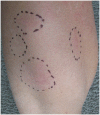Skin manifestations of inflammatory bowel disease
- PMID: 22347192
- PMCID: PMC3273725
- DOI: 10.3389/fphys.2012.00013
Skin manifestations of inflammatory bowel disease
Abstract
Inflammatory bowel disease (IBD) is a disease that affects the intestinal tract via an inflammatory process. Patients who suffer from IBD often have diseases that affect multiple other organ systems as well. These are called extraintestinal manifestations and can be just as, if not more debilitating than the intestinal inflammation itself. The skin is one of the most commonly affected organ systems in patients who suffer from IBD. The scientific literature suggests that a disturbance of the equilibrium between host defense and tolerance, and the subsequent over-activity of certain immune pathways are responsible for the cutaneous disorders seen so frequently in IBD patients. The purpose of this review article is to give an overview of the types of skin diseases that are typically seen with IBD and their respective pathogenesis, proposed mechanisms, and treatments. These cutaneous disorders can manifest as metastatic lesions, reactive processes to the intestinal inflammation, complications of IBD itself, or side effects from IBD treatments; these can be associated with IBD via genetic linkage, common autoimmune processes, or other mechanisms that will be discussed in this article. Ultimately, it is important for healthcare providers to understand that skin manifestations should always be checked and evaluated for in patients with IBD. Furthermore, skin disorders can predate gastrointestinal symptoms and thus may serve as important clinical indicators leading physicians to earlier diagnosis of IBD.
Keywords: Crohn’s disease; inflammatory bowel disease; skin disorders; ulcerative colitis.
Figures




References
-
- Agrawal D., Rukkannagari S., Kethu S. (2007). Pathogenesis and clinical approach to extraintestinal manifestations of inflammatory bowel disease. Minerva Gastroenterol. Dietol. 53, 233–248 - PubMed
Grants and funding
LinkOut - more resources
Full Text Sources
Other Literature Sources

